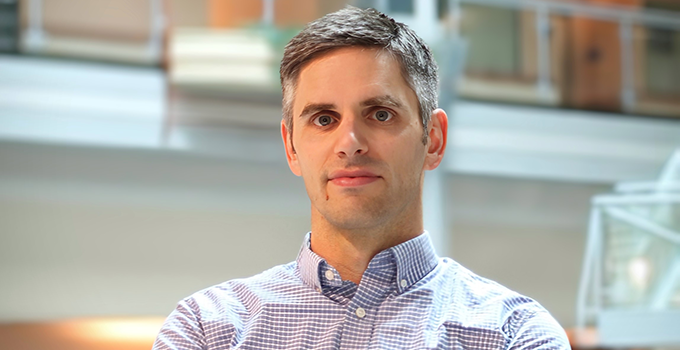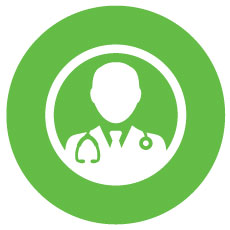Dr. David Cescon recently joined OICR as Scientific Director, Clinical Translation (CT). In this role, Cescon leads clinical and scientific aspects of CT initiatives, collaborates with supported researchers to design and implement clinical trials, and identifies new opportunities to further OICR’s mission.
Cescon spoke with OICR News about his work as a clinician scientist specializing in breast cancer, how we can leverage Ontario’s strengths to accelerate cancer research and more.
Can you tell us about your work as an oncologist and researcher?
I’m a medical oncologist and clinician scientist at Princess Margaret Cancer Centre. In that role, I have a lab-based research program largely focused on the development of new therapies and biomarkers for breast cancer. The overarching goal of that work is to understand why certain drugs we use in the clinic are effective for some patients but not for others, and why they sometimes stop working. We also investigate new therapies that may help address those unmet needs. We do that by identifying new cancer vulnerabilities or by testing new drugs that are in early phases of drug development. We evaluate those in the context of models that represent the current clinical landscape, which is rapidly shifting.
On the clinical side, I see patients with breast cancer, and I’m engaged in a lot of clinical research in addition to the delivery of care. That includes clinical trials and translational research. We have patients participating in a variety of research programs that are helping to either develop new technologies or new therapies that might improve outcomes for people with breast cancer.
Can you tell us what interested you in the role with OICR?
I’ve interacted with OICR over a number of years and most recently through our Phase II clinical trial that is supported by funding from the OICR Clinical Translation (CT) Program. Through that experience it became clear to me that CT is addressing important and timely challenges in clinical oncology. They are trying to bridge many of the things that I’m interested in. This includes emerging technologies related to diagnostic development, understanding the potential clinical utility of those technologies, matching them to therapies and ultimately delivering individualized care for patients by taking advantage of all those things that can improve outcomes. As a clinician scientist it seemed like a great opportunity to contribute to the overall mission of OICR. Ultimately, improving outcomes for patients in Ontario and globally by advancing the development of those kinds of strategies.
This role is also a way to further engage in collaborative work which has been one of the things that I’ve really enjoyed throughout my career – working in team-based environments locally, internationally, but also across the province of Ontario. The province has a lot of potential that may not be fully tapped. OICR is a unique umbrella organization that may have the ability to maximally leverage the strengths, infrastructure, talent, and engaged population of patients and families that exist in the province.
What do you see as the biggest challenges in advancing research discoveries into the clinic?
Keeping pace with the rapid emergence of scientific knowledge and technology platforms that are changing practice is a big challenge. To ensure that advancements can reach patients in Ontario, we must generate the appropriate data to demonstrate that they have clinical utility, can be feasibly delivered, and are cost-effective. All of these are necessary to be able to deliver healthcare in a publicly funded environment. I think that OICR can have significant impact in accelerating this progress through the work supported by CT.
Does Ontario have any unique advantages when it comes to moving discoveries to the clinic?
Ontario has a large and diverse population, and cancer care delivery is harmonized across the province. Our single payer system means that there is generally uniform delivery of care and relatively consistent treatment paths. In some jurisdictions, patients may be treated differently because of what insurance companies are willing to cover. The Ontario advantage is that we can capture the breadth and diversity of our 16 million plus population, engaged clinicians and researchers, and tap into our provincial infrastructures to investigate clinical and translational research questions.
How do you view the role of patient partners in research?
A huge amount of the work that I’m engaged in as a clinician scientist really depends on the active participation of patients. This includes the work that we do in the lab because patients donate samples, it includes all the translational work that we do in the clinic and of course it includes clinical trials which can’t be done without the contributions of patients and their families who volunteer to participate. My efforts in research are ultimately motivated by my interactions with patients and attempting to understand their needs such that we can improve the outcomes and the patient experience. It’s critical for us to make sure the questions we are asking are relevant to patients and that we make participation in research as accessible as possible. We are fortunate at OICR to have the very dedicated Patient and Family Advisory Council, and I am looking forward to working with them to integrate their expertise into the work of CT.
How has your experience at OICR been so far?
I have felt very welcomed by the CT team and by everyone at the wider Institute. Obviously, there’s a lot to learn, but I’m looking forward to engaging with colleagues from across all the different research areas that OICR is active in. Whether it is basic research or more applied, all efforts eventually converge on CT if they are going to impact clinical care. I’m looking forward to hearing their insights and discussing ways we can work together to bring research discoveries to patients.


